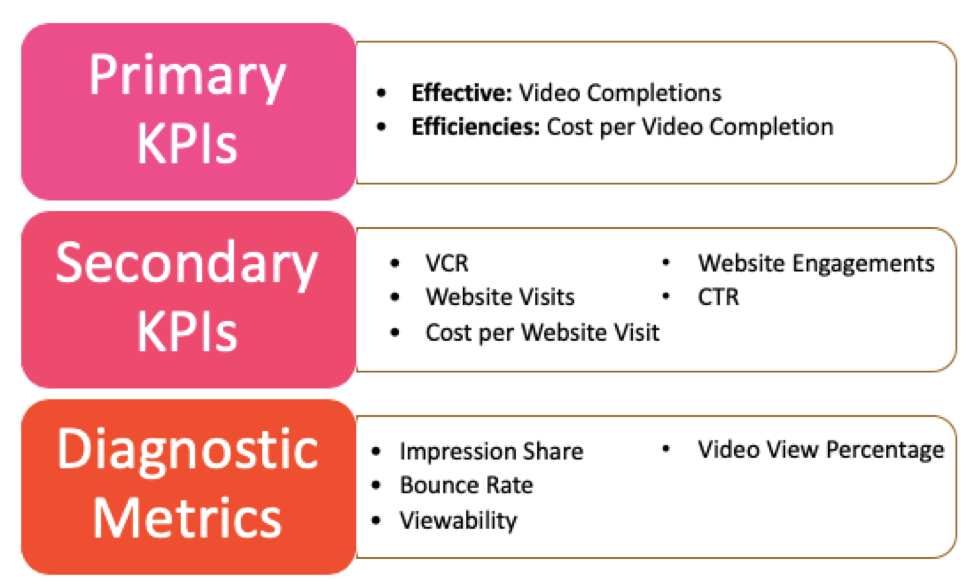So, what is a KPI, and what does KPI stand for? KPI stands for Key Performance Indicator. Key Performance Indicators are key metrics that allow you to measure the success (or not) of a campaign. Different KPIs are used to help make informed business decisions based on the performance of the initiative being measured. KPIs should be determined and a measurement framework should be built prior to launch to be able to identify if the initiative was successful or not. Tracking KPIs are essential to being able to measure success!
What is a KPI, what are they used for, & how do you use them?
What is considered a good KPI?
A key performance indicator could be any metric(s) that measures the success of your project. Your key performance indicators should be measurable metrics that easily allow you to identify the performance of a campaign. KPIs should ultimately measure your marketing efforts and help you reach your business goals. It’s mission critical to have a measurement framework decided on before you start spending money, so therefore they are an essential element in your digital marketing strategy. Take your time and be smart about choosing the right KPI metric to track each of your campaigns. Luckily, if you and other employees are unsure of what KPI metric you should be looking at, there are standard and recommended KPIs based on certain initiatives that are pretty easy to find online.
Below are a few commonly used KPI examples for measuring progress if a digital marketing campaign:
- Leads – a potential sales contact who expresses interest in your brands goods or services. Lead lists are used by employees to reach sales goals.
- Conversions – used to track specific user actions such as product purchases, form downloads, or newsletter signups
- Reach/Impressions – primarily used for awareness campaigns
- Return on Advertising Spent (ROAS) – used to measure a campaign’s monetary value of money spent versus earned
- Click-through Rate (CTR) – used to measure the engagement of an ad or specific engagement
- Conversion Rate (CVR) – used to measure the rate at which users are converting on a specific action
- Cost-per-Click (CPC) – used to measure the campaign’s efficiency on the spend needed to drive click-throughs
- Cost-per-Lead (CPL)/ Cost-per-Acquisition (CPA)/ Cost-per-Conversion – used to measure the monetary value needed to spend in order to generate a lead/conversion

What are KPIs used for?
KPIs are business metrics that track the effectiveness and efficiency of strategic objectives that align with an overarching strategic goal. These key metrics should be monitored throughout the length of the campaign to allow for optimizations to be made in an effort to ultimately reach your business goals and objectives.
Tip: Make sure that you’re able to track and report on the KPIs you’re planning on using, for example, tracking specific website events using a data analytics tool, such as Google Analytics. Talk to your analytics team, advertising partner or whoever is responsible for setting up web analytics/campaign tracking to make sure you’re focusing on the right metrics. You want to select the most effective KPI to track throughout your campaign to ensure your campaigns are optimized to achieve your objective.
How to use KPIs
KPIs and their corresponding measurement frameworks can change as often as your team/department/company’s strategic goals and objectives. Try to avoid altering your KPIs while a campaign/project is running; otherwise, you will have discrepancies in your data where certain ads looked like they were performing poorly because they were optimizing to a different metric (e.g. campaigns that were originally optimizing for reach will look like they are underperforming if the primary KPI is changed to CTR). Similarly, different initiatives and channels should have their own corresponding KPIs – for example, if you’re running an awareness-based campaign, the KPIs for social media ads should be different than that of an email campaign. Since your KPIs assist in performance measurement, it’s crucial you choose the most effective KPI to track your campaign objective. Once you review the data, based on your KPIs and via a web analysis, you’ll get a good understanding if you’ve chosen the right KPI.
Building a Measurement Framework
A measurement framework is an outline around how the success of something will be measured and what is needed to properly track success factors. Setting up strategic goals and aligning them with your KPIs are essential to building a measurement framework.
1. Determine the Goal
In order to identify which KPIs you will need to measure the success factors of your campaign, you will need to know what the specific goal is that you are working towards. The goal of your marketing campaign could be to generate 100 qualified leads or $100K in revenue or to simply build brand awareness. Regardless of your business goal, we will need to assign measurable metrics in order to monitor the performance of what leading indicators you’re tracking towards.
2. Determine Primary KPIs
A measurement framework itself is constructed of significant KPIs that are designed to analyze the performance of a campaign or initiative. Primary KPIs are the most significant KPIs that you will focus on for any real-time reporting or when analyzing the performance of your campaign and what you should be optimizing your marketing efforts towards. Some primary KPI examples would be leads for a lead gen campaign or reach/impressions for an awareness campaign, or video completions for a video campaign. You can have more than one primary KPI, but we recommend you limit it to one or two.
3. Determine Secondary KPIs
Secondary KPIs are where you can list additional metrics that are important to the campaign’s strategic objective. There might be four, five, or even six secondary metrics that are important to look at when analyzing the success of your campaign but aren’t your primary metric.
4. Determine Diagnostic Metrics
Diagnostic metrics look more at the health of your campaign rather than its success rate. Diagnostic metrics will look at the quality of your campaign’s engagement and may include metrics such as cost-per, conversion rate, engagement rate, website bounces or viewability rate.
5. Determine KPI Targets
KPI targets are targets that you’re looking for your KPIs to hit. These targets should be measurable and realistic numbers to help you stay on track. I would recommend creating KPI targets on the KPIs you’re optimizing towards, which could include only primary KPIs or potentially secondary KPIs as well. So, if your primary KPI is video views, you can set your KPI target to hit 10% more video view than you did in your last video campaign or even as specific as reaching 1,000 more Facebook users. Just make sure your performance measures are comparable (e.g. if you’re comparing a brand campaign on the East Coast from YouTube versus a social contest in the mid-west on Facebook, you’re going to get very different results even if they’re both running video campaigns and using similar KPIs).
6. Identify Benchmarks
Another important aspect of measuring your campaigns is identifying benchmarks. Comparable benchmarks will help you understand the progress of your campaign and how it’s performing. Understanding how your campaigns are performing against your benchmarks can lead to directional indicators of where optimizations need to be made to improve your campaign’s key performance. Benchmarks can be related to the platform where the campaign is running, the type of ad that is being run, industry benchmarks or even your own internal benchmarks.

Example of a Measurement Framework outlining Primary KPIs, Secondary KPIs, and Diagnostic Metrics for the goal of brand awareness through a video campaign.

Now that you know the answer to “what does KPI stand for,” and have studied KPI examples, do you have questions about which KPI best conveys the success or failure of your campaign? Need help tracking KPIs or building out a measurement framework? Our experts are here to help refine your marketing strategy and ensure your team achieves its business objective. Check out our analytics consulting services and let’s get in touch.



